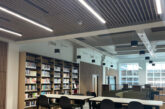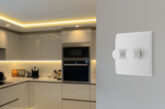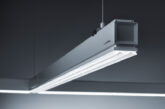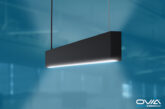
Zano Controls sit down with Professional Electrician and Installer magazine to debunk the ins and outs of lighting control for large LED loads and explain the key things to consider before getting started on a project that requires lighting control.
Controlling mixed loads on a single circuit
Adding lighting control to mixed LED loads on a single circuit can be hard work, no matter the lighting project or lighting control solution chosen. This is because each dimmable LED fitting or driver has different minimum and maximum levels that it can be adjusted to.
Imagine you’re adding lighting control to a space with a number of recessed GU10s, as well as LED strip lighting and some hanging, handcrafted pendants all on the same circuit. You need a product that can handle the respective loads of all fittings and fixtures and ensure that the lighting control all works in sync.
The key thing to look for is the capabilities of a lighting control product’s internal settings. It benefits the installer to have the opportunity to pre-set the control’s internal settings so that the lighting output does not dip below the capacity of the drivers that have the highest minimum level.
Not only does this make sure that the lighting control all works in sync, but that the controls are programmed to keep all the lighting within a consistent range of output, that works for all the fittings and drivers on the circuit, every time.
Multi-point lighting control
Dimming LED from more than one point on a single circuit is a solution that’s often restricted to expensive, often bespoke lighting systems with complex configuration requirements. If a client wants to dim and control the lighting from multiple locations on a single circuit it can be done cost-effectively without requiring expensive rewiring or complicated computer programming and this is an element of lighting control that’s often overlooked by installers.
Take Zano Controls’ ZBARLED as one example. The ZBARLED is a remote dimming pack that can be installed through a break in the circuit or a junction box, works with existing twin and earth cable and can be paired with up to 32 rotary control points. It works with specially designed ZBARCR rotary controllers or retractive push-up/down (toggle, rocker etc.) switches and push/button switches.
The versatility of the ZBARLEDs pairing with different control options means that there are no restraints to your installation and that you and your clients can select the controls that fit the character and usage of different areas.
Creating flexible lighting control for large spaces
When adding lighting control to a larger LED-lit room, you need a lighting control product that can handle all the different possibilities that that space will be used for and makes it easy to create a lighting design scheme for multi-use spaces.
For example, the same commercial venue could be rented out for conferences, performances, weddings, health and exercise, or worship, all of which of course require specific and varied lighting conditions. In some of these scenarios, being able to achieve low-level lighting will be just as important as making sure the finished result provides optimal lighting where and when needed.
A product that can be multi-functional and control the lighting to low levels smoothly as much as it can make use of the circuit total load, without any flicker, buzz or dropout is imperative.
Reducing energy costs and increasing efficiency
Not only is LED up to 80% more energy-efficient than conventional lighting but adding a lighting control solution to a project reduces overall energy usage significantly in comparison to standard on/off switches.
As outlined in a study by Gordon Lowry on energy-saving claims for lighting controls in commercial buildings, when provided with the ability to control the lighting levels themselves, the end-user will opt for lower lighting levels than the recommended lighting standards, based on their own personal preferences or levels of ambient light.
Greater scope for lighting control can help your clients save on their energy consumption by up to 47%, which is welcome news for commercial clients whose energy bills may be significant, and who would like the chance to cut costs where they can.
The challenges of Inrush current
Many LED drivers and fittings produce a large spike of current as they turn on, which can be much higher than the advertised wattage of the LED on its packaging. Inrush is the spike in current that is drawn by the LED power supply. While it mostly occurs when the circuit is first switched on, it can also happen during the mains cycle as the reservoir capacitor requires a charge.
The bigger the spike or the longer the duration, the more it affects an LED installation, increasing the load and potentially changing the dimmer or lighting control solution you need to install.
Many lighting control options, no matter how bespoke or tailored to your specific lighting requirements, aren’t powerful enough to cope with Inrush current. Flicker, buzz and even LED dropout are by-products of Inrush current wreaking havoc on an LED install.
When dealing with large loads, you need a lighting control solution that is powerful enough to handle the various complications of Inrush and can provide flicker-free, silent, and reliable lighting control.
This is where Zano Controls’ ZBARLED really comes into its own. With different wattage versions available depending on the project specification and the ability to add more ZBARLEDs to an install to control even higher loads (by wiring the ZBARLED remote dimming packs in parallel), you can be confident that the ZBARLED can handle even the most dramatic of energy spikes produced by problematic drivers and fittings.
Find out more here








